
Key Points
- It’s important to learn the fundamentals before you dive into the markets. Read this comprehensive guide to learn more and get started.
- A stock is a small piece of a company. When you own a stock, you own a piece of the company.
- You can begin trading stocks using brokers like Webull, M1 Finance, and Stash.
This might be hard to believe, but investing in stocks is not hard. Even for beginner investors.
Your parents will have you believe that the stock market is a scary place. That if you invest in stocks, you’ll be like a sheep in a pit with a bunch of hungry wolves.
You may have even heard that investing in stocks is basically “gambling.”
This is a blatant lie that stems from a lack of knowledge and understanding of how the stock market works.
Stocks have been a cornerstone of building wealth for investors for over a hundred years. That will never change. If you want to be serious about building wealth for you and your family, stocks are a great way to do it.
In this guide, you’ll learn the basics of everything you need to know about investing in stocks. You won’t find a more comprehensive beginner’s guide on stocks anywhere else.
Here is an overview of what you’ll learn today.
Stock Investing Basics: A Powerful Beginner’s Guide
- Stock basics
- Investing in stocks
- Protecting your stock investments
- Alternatives to investing in stocks
- Best tools for stock investing
Stock basics
In this section, you’ll learn everything you need to know all the fundamentals about stock investing for beginners. This will lay the groundwork for you to follow along with the rest of this guide, so be sure to not skip past this part.
What is a stock?
The simple version
: a stock is a small piece of a company. When you own a stock, you own a piece of the company.The more complex version: a stock is a type of security that represents ownership of a company. When you own shares of stock in a company, you have equity in the company.
You may also hear stocks referred to as equities, and vise versa. Don’t let this confuse you, they’re both the same thing.
For example, if you own shares of Apple stock, you have equity in Apple which simply means you own part of Apple. Pretty cool, right?
Why do companies issue stock?
Companies will issue stock to raise money to expand their operations.
For example, in 1992, Starbucks only had 165 locations. It’s not that business was bad, but they wanted to expand faster.
That same year they did an initial public offering (IPO) to raise money to expand the Starbucks brand. Since then, they’ve expanded their business to over 30,626 locations.
That type of growth would simply not have been possible if they didn’t raise money by making the company public with an IPO.
Selling shares of stock is just one way a company can raise capital.
For example, if a private company didn’t want to give up ownership (think Chick Fil A), it could still raise money by issuing bonds or taking out loans.
The downside to this is that both bonds and loans are a type of debt financing. This simply means that the company will have to pay back the bonds and loans with additional interest. And no one likes paying interest.
On the flip side, issuing stock allows a company to raise money without taking out debt and making extra interest payments. This is known as equity financing.
By selling pieces of ownership to the public, a company can raise money and not pay anyone.
How do companies issue stock?
You just learned why a company issues stock. But now the question is, how do they do it?
Companies issue stock through an initial public offering (IPO). You’ve likely heard this term before, but I’ll break down its meaning.
The words “public offering” in the stock world are used to describe a company selling stock to the public. The company is offering stock to the public.
So an initial public offering is just the initial (first) time a company is selling shares to the public. An IPO. Get it?
Let’s say for example Chick Fil A needed to raise money. They wanted to invest in research to make their chicken sandwiches even more delicious.
Chick Fil A is a privately owned company. To make the company publicly owned and available for the public to buy, Chick Fil A would need to file for an IPO with the SEC. This is also known as going public.
Once Chick Fil A has gone public, shares of their stock will be available to the general public.
Stocks can be purchased through a stock market exchange like the New York Stock Exchange (NYSE) or Nasdaq.
Stock market exchanges facilitate the transfer of stock from companies to the public. They do not own the shares of stock itself.
You can think of a stock exchange like a farmer’s market. At a farmer’s market, there are dozens of individual booths set up with different sellers.
The farmer’s market doesn’t own what each booth is selling, they are simply creating a marketplace to bring everyone together and make the selling easier. The stock market works the same way.
How do I buy stock from a company?
Although a stock market exchange makes stocks available to the public, you can not buy directly from an exchange. Instead, you’ll have to use a broker.
However, don’t let the word broker scare you. It’s nothing fancy. Nowadays, you can buy and sell stocks from the comfort of your home without having to scream into a phone like you see in the movies.
Modern broker’s like M1 Finance and Webull allow you to easily buy and sell stocks, even from an app.
You can also use services like Acorns and Stash to automatically invest your money for you based on your investing goals. It’s pretty extraordinary.
Read our full reviews for the services mentioned above:
What is the stock market?
The stock market is a place where investors can go to buy and sell shares of publicly traded companies.
The term stock market is broadly used to describe the combination of different stock exchanges. The U.S. stock market has dozens of stock exchanges, but the two major exchanges are the New York Stock Exchange and Nasdaq.
There are hundreds of stock exchanges around the world. Some other popular ones include the London Stock Exchange, Hong Kong Stock Exchange, and Deutsche Börse.
It’s important to note that other financial securities can be traded on the stock market other than stocks. For example, you can trade ETFs, corporate bonds, REITs, and derivatives on the stock market.
Now that you know what the stock market is let’s go over some common terms you might see being used when talking about the stock market.
Stock market indexes
You’ve likely seen terms like S&P 500 and Dow Jones tossed around on the news.
Sure, you know that these are related to the stock market, but have you ever wondered what they actually mean?
Both the S&P 500 (Standard & Poor’s 500) and Dow Jones (Dow Jones Industrial Average) are types of stock market indexes (also called indices).
There are about 5,000 indexes in the U.S. stock market—the S&P 500 and Dow Jones are two of the most popular indexes.
A stock market index is an average price taken from a group of stocks to determine the market’s overall performance.
For example, the S&P 500 is often used to track the performance of the entire market. However, the S&P 500 only contains 506 (this number is always changing) stocks. That’s not even close to the 6,267 stocks listed on just the NYSE and Nasdaq alone.
But, since the S&P 500 tracks 500 of the largest companies in the U.S., it is a good representation of the entire market.
It’s the reason you typically see S&P 500 and Dow Jones being used synonymously with the stock market.
An easy way to think of a stock market index is to imagine a survey. When a survey is conducted, the research company only gets data from a select group of people. However, they use the results from that data to make assumptions about the entire population.
A stock market index is doing the same thing.
Stock market sectors
A stock market sector (not to be confused with economic sectors) is a group of stocks within an individual part of the entire stock market.
A sector is considered to be a broad classification of groups of stocks. That’s because within individual sectors, there are dozens of more specific individual industries.
You can think of a market sector as a single slice of Thanksgiving day chocolate pie. If the entire stock market is the whole chocolate pie, the individual sectors are just individual slices.
And to make things even more complicated, within those individual slices of pie, there are dozens of other individual slices of pie called industries. Pies for everyone.
The bigger picture looks like this: stock market > sectors > industries > individual stocks.
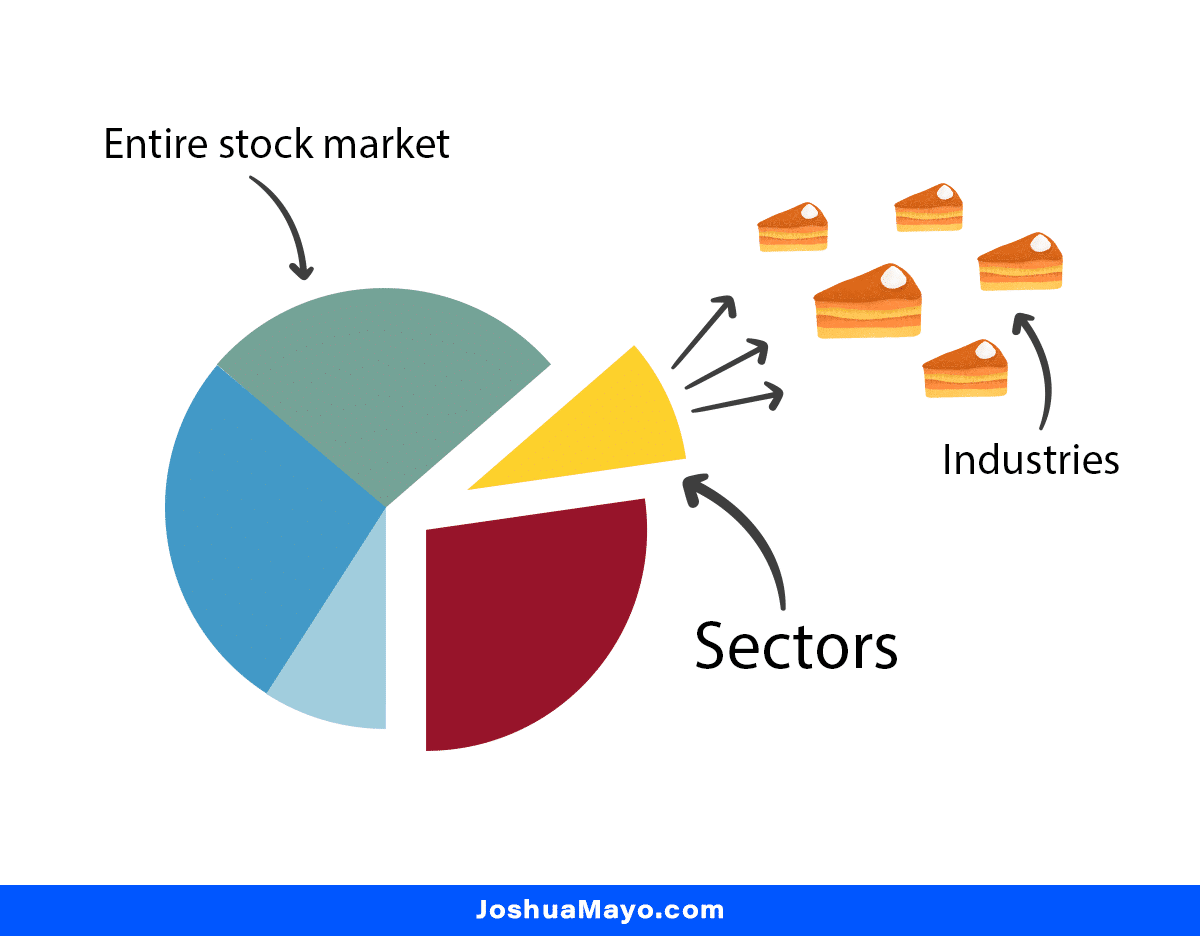
Stocks in individual sectors share common characteristics because they are companies within the same industry.
What does that mean? It means similar companies get grouped together.
For example, Apple and Microsoft are both in the information technology sector because they’re both companies that deal with technology.
Would you say that McDonald’s is in the health care sector? Of course not. Because McDonald’s is not a health care company. Only healthcare-related companies would be in the health care sector.
Stocks are categorized into sectors to help investors make better investment decisions. For example, investors can use sectors to diversify their portfolios.
Buying stocks or funds across several sectors will help mitigate the risk of a substantial portfolio loss if a single sector is in a downturn.
If you have no way of distinguishing between sectors, you may accidentally invest too heavily in a single sector. Therefore, categorizing companies into sector’s gives you a clearer image of how well your portfolio is diversified.
Does all of that sound too complicated? Don’t worry. This diversification can easily be accomplished by investing in exchange-traded funds (ETFs) or by investing in pre-built portfolios with companies like M1 Finance.
There are 11 stock market sectors in total, they are:
- Energy
- Materials
- Industrials
- Consumer Discretionary
- Consumer Staples
- Health Care
- Financials
- Information Technology
- Telecommunication Services
- Utilities
- Real Estate
I want to mention that these 11 stock market sectors are based on the Global Industry Classification Standard (GICS), which is only one out of many different classification systems used to categorize stocks.
That’s right, it gets even more complex. But don’t worry, I don’t want to expound on that too much in this guide.
If you’d like to learn more about the different market sector classification systems, here’s a great article on ETFdb.com.
Stock market industries
Stock market industries are a subcategory of sectors. Industries allow investors to get an even closer look at businesses with similar characteristics.
For example, Dollar General, a discount retail store, and Coach, a luxury brand, are both in the consumer discretionary sector. That’s because they both sell merchandise that is non-essential.
However, both are very different companies and therefore in different industries.
Investing vs. trading
You’ll need to understand that there is a very clear difference between investing in stocks and trading stocks.
This guide is teaching you about the fundamentals of stock investing, not stock trading.
Let’s go over both.
What is stock trading?
Stock traders (also known as day traders) aim to profit from short-term volatility in the markets.
By buying low and selling high, traders can capture windows of profit that can add up quickly over time.
For example, a stock trader may buy shares of Apple stock at $441, and then sell those shares at $452 a few hours later. That $11 in profit may not seem like a big deal, but when you are trading hundreds or thousands of shares, it can turn into big profits.
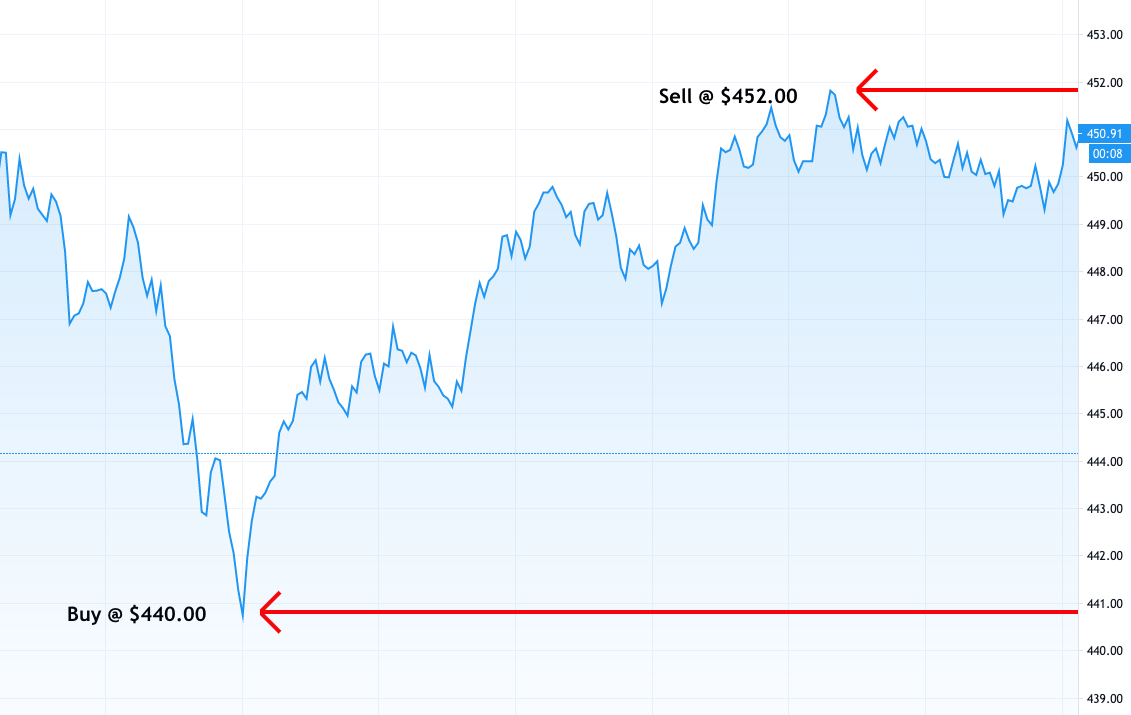
Stock trading is extremely risky and can be borderline gambling if you do not have a predefined set of rules and strategies.
Although I’ve traded stocks in the past (even penny stocks), I wouldn’t recommend most people do it. It takes immense practice and discipline—and frankly, there are better ways to make money on the stock market.
What is stock investing?
Stock investing is the act of slowly building wealth over time.
By investing in stocks, index funds, ETFs, bonds, and other investment instruments, investors can capitalize on the success of companies and the growth of the overall economy.
Stock investing comes with a host of benefits. Not only is it safer than stock trading, but you can also take advantage of wealth-building perks like dividends, interest, and capital appreciation.
While the market does fluctuate a lot, stock investors can ride out the ups and downs because they are in it for the long run.
For example, if the stock market “crashes” or starts a downtrend, you don’t have to panic. The market will eventually correct itself, and you’ll recover your losses and be back to building wealth.
Types of stocks
The word stocks is a general term used to describe a share of ownership in a company. However, not all stocks are created equally. And that’s why they are categorized separately.
Some are riskier but can be more profitable, and others are safer but will grow slower.
It’s important to know the difference so that you can make more informed investment decisions.
Here is a list of the different types of stocks, along with a short description:
- Dividend-paying stocks — Also called income stocks, dividend stocks make quarterly payments to shareholders. These payments are taken from the company’s earnings. Investor’s like dividend-paying stocks because you earn passive income every quarter.
- Blue chip stocks — Blue chip stocks are shares in a large, stable, established company with a proven financial track record. Think companies like Google, Amazon, American Express, Goldman Sachs, Coke, Nike, and Walmart. These stocks are not considered risky and are good investments.
- Speculative stocks — Speculative stocks are shares in companies with little financial history and are in the business of developing products or services in new, untapped markets. These stocks are considered risky.
- Growth stocks — Growth stocks are shares in a company that is expected to have high earnings. Many stocks that are considered growth stocks are also considered blue chip stocks. For example, companies like Amazon, Facebook, Apple, and Netflix are all growth stocks.
- Value stocks — Value stocks are viewed as stocks that are undervalued. Investors have reason to believe that the company will become more valuable in the future and that buying stocks now will result in large profits later on. An example of this is Walt Disney Co, Walmart, and JPMorgan Chase.
- Penny stocks — Penny stocks, by definition, are stocks that trade under $5. Penny stocks are usually issued by startups or small companies that need to raise money. If the company does well, these stocks can increase in value substantially. For example, by definition, Apple was a penny stock for over 25 years when it traded below $5.
- Cyclical stocks — A cyclical stock is a stock that’s value follows the health of the overall economy. If the economy is down, these stocks lose value. If the economy is doing well, so are these stocks. These are typically stocks from companies that sell non-essential products or services, meaning you could survive without it. Examples include Honda, Smith & Wesson, eBay, and Best Buy.
How to make money with stocks
Finally, the part of this guide you’ve been waiting for.
This is really the only reason you own stocks—to make a profit. Otherwise, why risk your money?
So the big question, how do you make money with stocks? It’s simple. Through capital appreciation and dividends.
Let’s go over both.
Capital appreciation
Capital appreciation is the profit you get from the rise of an investment. For stocks, it’s the difference between the price you purchased the stock and the price it’s currently trading at.
If you buy a stock at $20 and hold it until it reaches $40, you have earned $20 in capital appreciation.
The moment you sell the stock, your capital appreciation turns into a capital gain.
You may sometimes notice capital gains or appreciation being expressed as a percentage. For example, earlier, you bought a stock at $20 and sold at $40. This is a $20 gain, but it’s also a 100% return on your investment. You gained 100% more than you originally invested.
If that same stock went up to $60, that would be a 200% return on investment. If the price went down to $15, that would be a -25% return on investment. That’s right, you can experience losses as well.
Just like your investment can earn capital appreciation and capital gains, it can also experience capital depreciation and capital losses.
Dividends
You purchased shares of stock in a company. Now you are a part owner. As an owner, you’ll also get owner benefits, such as dividends.
Dividend is just a fancy way of saying payment. When a company pays its shareholders dividends, it’s making payments to them.
Dividends are taken from a company’s profits. Every quarter (3 months), companies release an earnings statement.
If earnings are low, dividends are almost always the first thing to get the boot. However, with more established corporations, this is not as common.
Not all stocks pay dividends. Some companies will reinvest earnings back into improving their products and services. For example, Apple paid dividends between 1987 and 1995, but then stopped until 2012 before resuming.
An example of a stock that pays dividends is IBM. IBM currently pays about $1.63 in dividends for every stock, every quarter. This comes out to $6.52 per year per share of IBM stock.
On the surface, that might not seem like a lot of money. However, for investors who own thousands of shares, that can really equal a nice paycheck.
What makes stock prices go up or down?
When you look at any stock chart, you’ll notice that it looks like a rollercoaster ride at Six Flags. Up and down, up and down. What’s up with this? And is there a way to predict the movement?
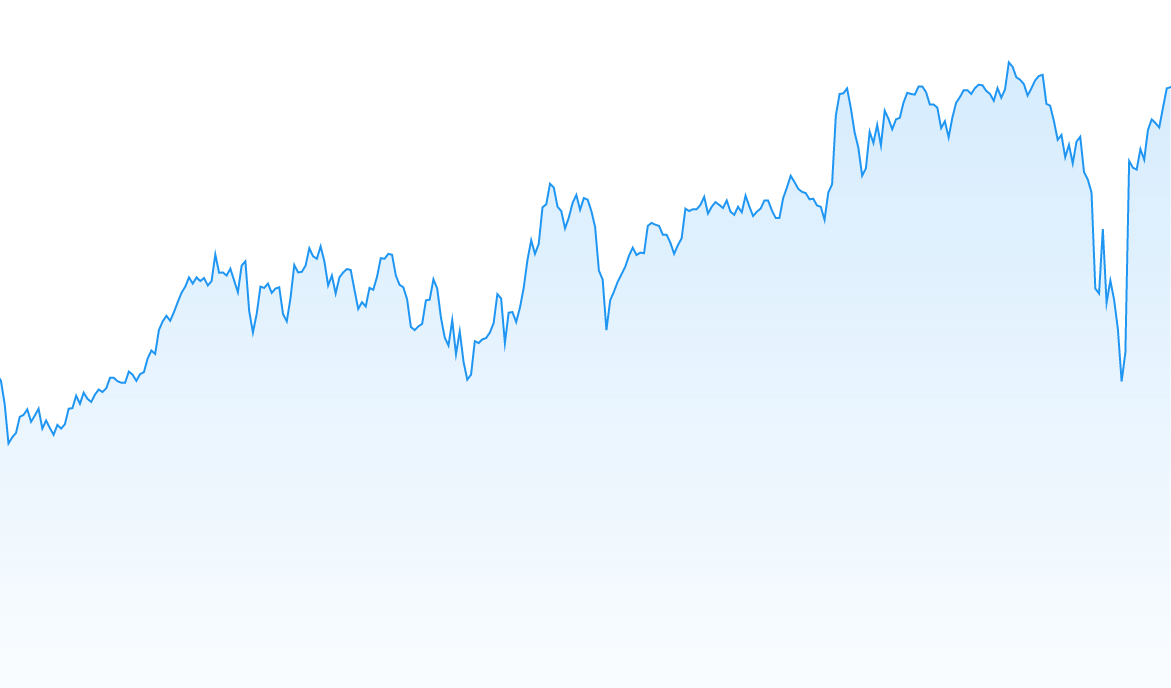
Stock prices are affected by many market forces such as earnings, news, product releases, and even company leadership changes.
However, those aren’t the biggest factors that drive stock prices. The largest driving force behind stock price fluctuations is human emotions. That’s right, people.
The stock market would be a simple place if you could predict the movement of a stock by simply looking at a company’s earnings. In fact, we’d all be millionaire stock investors because it would be easy to predict the movement.
However, that is far from the reality. In the real world, stock movement can be unpredictable and even appear random. And to be honest, it sometimes is.
Anyone who claims they can predict the direction of the stock market is selling you a pen with no ink.
Of course, through the use of technical analysis tools like stock charts and indicators, you can make a better prediction of stock movement, but it will never be 100% certain.
Stock prices go up or down based on the overall sentiment around a stock. This often creates irrational price changes and volatility.
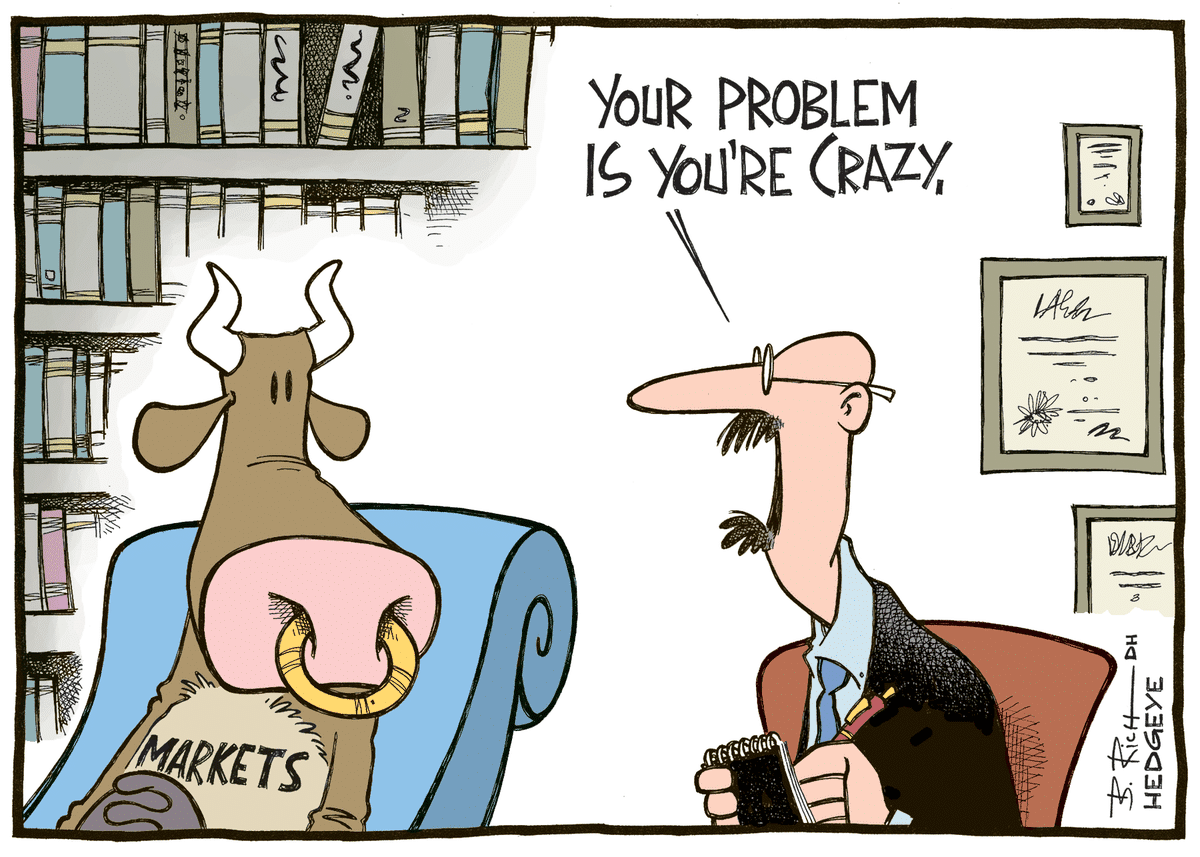
A famous example of this is the dotcom bubble. During this period, dozens of internet companies were thought to be worth billions of dollars. Yet, most of these companies never turned even the smallest profit.
Of course, you know how that ended. The bubble popped. All these internet companies became worthless. Investors lost billions of dollars.
So what caused the irrational stock price movement of these internet companies? Human emotions.
If you finish reading this section of the guide and only learn one thing, it’s this: no one can predict 100% how a stock will move. But one thing is certain, stocks are extremely volatile and can change in price fast.
Investing in stocks
In this section, you’ll learn all the details about how to begin investing in stocks. You’ve seen it in movies, you’ve watched it on the news, but now it’s time for you to take action and invest in your first stocks. Continue reading to learn how.
Investing for income vs. growth
There are different strategies you can use when it comes to investing in the stock market. In this guide, I want to focus on two specific categories: investing for income and investing for growth.
Both are legitimate ways of investing in stocks. However, both require you to invest in a specific type of stock. And depending on your investing goals, you’ll need to know which stocks to invest in to get the proper results.
Let’s go over both these categories in detail.
Investing in stocks for income
Do you want to live off of your stock investments? If so, you’ll want to invest for income.
This type of investing will require you to buy stocks that pay dividends. But not just any dividends—high-dividends. High-dividend stocks are known to have more competitive dividends compared to other stocks.
As you learned earlier in this guide, a dividend is a payment that a company makes to its shareholders. These payments happen once every quarter—four times a year.
Many investors can earn well over six-figures of income in a year—from dividends alone.
So, where do you find high-dividend stocks? And how do you start investing in them?
First, to find high-dividend stocks, simply search Google for “high-dividend stocks.” NerdWallet has a nice list that they seem to keep updated with the best high-dividend stocks.
Second, how do you start investing in them? If you already have a brokerage account, you can easily buy these stocks from your broker.
If you don’t have a brokerage account, I’d recommend opening one with Webull. Webull offers $0 commission and $0 fees on all trades. The service is completely free.
You can also purchase high-dividend ETFs. These ETFs are made up of dozens of the best dividend-paying stocks and will provide you with more diversification than buying individual stocks.
Investing in stocks for growth
If you are investing for growth, you are seeking to build your wealth through capital appreciation.
As you learned earlier in this guide, capital appreciation is the profit you get from the increase of an investment. For stocks, it’s the difference between the price you purchased the stock and the price it’s currently trading at.
Unlike investing for income where you get instant results
, investing for growth requires more patience. But it can pay off big.Facebook is an excellent example of a growth stock. When they first IPOed, they offered their stock at $38 per share. Their stock is now trading at $250+ per share.
If you were investing in stocks for growth, you would have purchased Facebook stock knowing it had great potential to grow and increase your net worth.
Let’s say, for example, you bought 100 shares of Facebook stock when they IPOed. You would have spent $3,800. 100 shares * $38 = $3,800.
At its current trading price, your original investment would now be worth well over $25,000. That’s a $21,200 profit. And that’s only 100 shares of stock. Imagine if you invested in 1,000 shares, or 10,000 shares, or more.
Now the question is, where can you find growth stocks? And how can you start investing in them?
A simple Google search of the term “best growth stocks” will give you the results you need. For example, this Investopedia list gives you a few of the best growth stocks to invest in.
Alternatively, you can remove all the complexity and simply invest in growth stock ETFs.
You can purchase growth stocks and growth stock ETFs at any broker. If you already have a brokerage account, you can buy stocks from there.
If you don’t have a brokerage account, I’d recommend opening one with Webull. Webull offers $0 commission and $0 fees on all trades. Commissions can add up over time and eat into your profit. But with Webull, the service is completely free.
How much money do I need to invest in stocks?
The simple quick answer: you can start investing in stocks for as little as $1. How? I’ll explain.
I can’t tell you how many times I’ve heard people say, “the stock market is for rich people.”
That may have been true 80 years ago, but today, anyone can invest in stocks. And you don’t need millions of dollars to get started.
For example, take services like M1 Finance or Stash. Both these services will allow you to invest using fractional shares.
A fractional share is a small piece of a stock. Fractional shares allow you to start investing in major stocks like Apple, Google, Tesla, and Amazon for as little as $1.
Yes, you read that right. You can start investing for as little as a single wrinkled George Washington (that’s who’s on the $1 bill in case you were wondering).
Of course, your returns won’t be incredible. With only $1 invested, you can’t possibly expect to get a million dollars in return, right? However, the idea here is to just get started.
Get the idea out of your head that you need at least $1,000, $10,000, $20,000 before you can start investing. No, you don’t. If you wait until you’ve saved up $1,000 to start investing, you’ll likely never start investing.
Start today. Start now. If you’re reading this guide, I’m making the assumption that you are not interested in spending 10 hours every day researching and investing in stocks individually.
You aren’t interested in making this your full-time job. Instead, you just want to start investing in stocks to take advantage of all the gains and compound interest. You want to build your wealth substantially for years to come.
Perfect! Many millionaires have been created this way. Don’t think for a second that you have to be invested full-time in the stock market to make a fortune. Because you don’t. Stock investing can be as passive as you want it to be.
As I’ve already mentioned, sign up for services like M1 Finance or Stash. These services are registered brokers that allow you to buy and sell stocks and other investments.
Additionally, you can use these services to automatically invest your money based on your goals and risk tolerance. For example, M1 Finance has dozens of pre-built expert portfolios that you can choose from. They even have portfolios that mimic billion-dollar hedge funds like Berkshire Hathaway.
You can also use Acorns to automatically invest your spare change for you daily. For example, if you purchase a cup of coffee for $3.28, Acorns will automatically round that purchase up to $4 and invest the difference of $0.72.
This means you don’t have to spend any time researching individual stocks and manually building your portfolio. It’s all done for you.
However, maybe you do want to spend hours researching and building a custom portfolio. This is also great. You can create a custom portfolio using M1 Finance or Webull.
Whatever you decide to do, understand this: you don’t need a significant amount of money to start investing in stocks. Start today, even if it means only investing small amounts at a time.
» Also read: 13 Alternatives to Investing in the Stock Market
Protecting your stock investments
In this section of the stock investing for beginner’s guide, you’ll learn how to protect your stock investments. The market can be a scary place—learn how to properly manage your portfolio to prevent big losses.
Diversifying your stock portfolio
Diversification sounds scary, but it’s actually a very easy concept. Let me explain.
To diversify your portfolio simply means
to spread out your money into different types of investments. Doing this will reduce your long term risk to market volatility.Imagine this:
You have $10,000 to invest. You decide to put all $10,000 toward buying Facebook stock.
And let’s say, purely for the sake of this example, Facebook’s stock is trading at an even $100. With $10,000 to invest, you buy 100 shares of stock. 100% of your portfolio is made up of Facebook stock.
One day, Mark Zuckerberg decides it’s a good idea to change the name of Facebook to Koobecaf. The market reacts to this change negatively and all of a sudden Facebook’s stock plummets down to $1.
Guess how much your original $10,000 investment is worth now? Yup, $100. You lost -$9,900.
Think that sounds unrealistic? That would never happen to a stock, right? Wrong. Remember Pier 1 Imports? The popular furniture and decor retailer. Their stock used to trade at almost $500. Guess how much it’s trading at today? About $0.20.
What about the once-beloved Blockbuster? At one point the stock was trading at a high of $30. And today, it’s trading on the OTC market at less than $0.03.
Granted, these drastic crashes didn’t happen overnight, but they did happen fast, relatively speaking.
That’s why diversifying your portfolio is so important. By spreading out your money across different types of investments, such as stocks, ETFs, bonds, and index funds, you are able to reduce your risk.
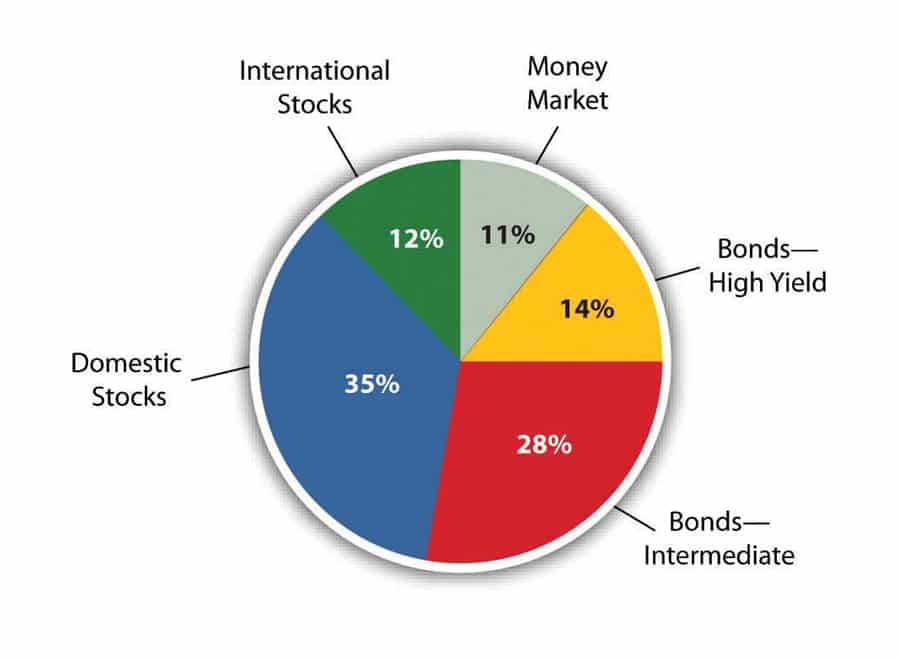
If one investment in your portfolio is declining, your entire portfolio won’t be negatively affected because you have other investments that are doing well. They balance each other out.
I don’t want to get into the nitty-gritty of how exactly to diversify your portfolio down to the exact percentages and number. That’s not the point of this guide.
For most of us, we can use services like M1 Finance to automatically buy investment portfolios that are expertly built and pre-diversified.
If you already have a brokerage account with a different service, you can simply buy a mixture of stock ETFs, bond ETFs, and other funds.
These funds are already diversified because they are essentially baskets that hold hundreds of individual stocks and other securities.
Best stocks for beginners
The short answer: beginner’s should focus on investing in ETFs and index funds instead of individual stocks.
If you absolutely want to invest in individual stocks
, as a beginner, it’s better to invest in blue chip stocks. These are stocks from established companies that have a long track record of making profits.Generally speaking, there is no “best” stock for beginners. It’s not that black and white.
For example, some investors might think that Tesla is a fantastic stock to invest in. On the flip side of the coin, other investors would say it’s the worst stock in the last 20 years.
Who’s opinion is correct? Neither. Everyone is entitled to their opinion, and there is no one size fits all in the investing world.
As a beginner stock investor, I would instead ask you to shift your focus away from investing in individual stocks. Instead, you should focus on investing in funds that hold multiple stocks in different sectors such as ETFs.
The problem with investing in individual stocks is that it requires a significant amount of time, skill, and energy. You’ll have to spend most of your time researching, learning, studying, and analyzing the markets.
By investing in ETFs, you are getting multiple benefits, including:
- Higher returns than most institutional investors and hedge funds
- Instant diversification
- Good liquidity because ETFs can be bought and sold on the stock market like stocks
- A variety of options to choose from including index ETFs, sector/industry-specific ETFs, and more
If you don’t have a broker yet and need to get started investing in, I’d recommend M1 Finance or Webull. Both these services are completely free and will allow you to start investing in ETFs today.
Alternatives to investing in stocks
Nowadays, there are plenty of ways you can profit from the stock market without having to buy individual stocks.
Many of these alternatives will give you instant diversification and even better returns than buying individual stocks.
I would highly recommend most beginner stock investors not buy individual stocks.
At the end of the day, you can get better returns, protect your investment, and not have to spend hours researching stocks if you use any of these alternatives.
Let’s go over them.
Exchange-traded funds (ETFs)
An ETF is a group of securities (such as stocks) that trade on the stock market and track an underlying index, sector, industry, or strategy.
For example, some ETFs track indexes such as the S&P 500 index. When the S&P 500 is up, the ETF’s price is up. When the index is down, so is the ETF.
Some ETFs track specific market sectors or industries, such as health care, technology, or oil.
You can invest in bond ETFs designed to track a variety of bonds, including corporate, municipal, U.S. Treasury, high-yield, and more.
There are (quite literally) ETFs for anything you can imagine.
ETFs are my personal favorite way of adding instant diversification to my investment portfolio.
Since an ETF is a basket of individual investments, such as all 506 stocks that make up the S&P 500 index, you don’t have to worry about your portfolio experiencing sharp swings.
Another benefit of buying ETFs is that they are traded like stocks on the stock market. Does the name exchange-traded funds make sense now? An ETF is simply a fund (like an index fund or mutual fund) that can be traded on a stock exchange.
You can purchase ETFs at any broker.
Index funds
An index fund (a type of mutual fund) is a group of stocks that track an index. Get it, an index fund?
There are index funds that track the S&P 500 index, Dow Jones, Nasdaq Composite, and many more. Since there are thousands of indexes in the U.S. stock market, there are also thousands of different index funds.
Index funds are awesome investments because they give your portfolio diversification without having to buy any individual stocks.
For example, there are two ways to buy the S&P 500 index (well, more than two, but for the sake of this example, only two). You could buy all 506 stocks that make up the S&P 500 index, which would cost you over $30,000. Or, you could buy a $300 S&P 500 index fund from Vanguard, Fidelity, or any other popular brokers.
The $300 would give you the same exact results as buying all the stocks individually. That’s because when you buy shares of an index fund, you are technically buying all of the stocks that make up the fund.
Index funds are very similar to ETFs, which you learned about above. The major difference is that ETFs are bought and sold on the stock market like stocks. Index funds, however, are not.
Robo-advisors
Another great alternative to buying individual stocks is to use a robo-advisor. There are plenty of great robo-advisors available nowadays. Most brokers have some form of robo-advisory or automated investing.
My recommendation would be M1 Finance. M1 Finance is completely free and allows you to invest in entire pre-built expert portfolios.
For example, with M1 Finance, you can invest in a portfolio designed to mimic some of the wealthiest hedge funds in the U.S.
Take Warren Buffett’s Berkshire Hathaway—M1 Finance has an entire portfolio dedicated to copying Warren Buffett’s investment portfolio for the Berkshire Hathaway hedge fund.
There are over a dozen other hedge fund portfolios you can invest in with M1.
How is M1 able to copy these hedge fund portfolios? Simple. A money manager that manages over $100 million in assets is required to report their long term equity holdings to the SEC, every quarter.
This means you can technically invest with these successful hedge funds that are normally reserved for millionaire and billionaire investors.
Pretty cool, right? Get started with M1 Finance today. The service is free to use, so you’ve got nothing to lose.
Best tools for stock investing
Here are a few lists of the best tools you can use for investing in stocks. These are tools I myself use regularly.
Best stock brokers
Here are some of the best stock investing brokers to use for beginners.
Best stock research sites
Here’s a list of stock research websites you can use to find the latest stock news
Best stock charting sites
Here’s a list of some of the best free stock chart websites. TradingView is by far my favorite stock charting website, and it’s completely free.
Conclusion
I hope that by reading this guide, you have the confidence to start investing in stocks. The stock market can be risky, but it does not have to be a scary place. And much of the risk associated with the stock market can be mitigated by arming yourself with knowledge.
About the author








